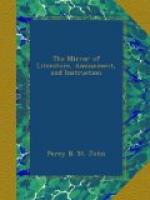The steam-engine therefore consists of two distinct parts,—the boiler, which is at once the generator and magazine of steam, and the cylinder with its piston, which is the instrument by which this power is brought into operation and rendered effective. The amount of the load or resistance which such a machine is capable of moving, depends upon the intensity or pressure of the steam produced by the boiler, and on the magnitude of the surface of the piston in the cylinder, upon which that steam acts. The rate or velocity of the motion depends, not on the power or pressure of the steam, but on the rate at which the boiler is capable of generating it. Every stroke of the piston consumes a cylinder full of steam; and of course the rate of the motion depends upon the number of cylinders of steam which the boiler is capable of generating in a given time. These are two points which it is essential should be distinctly understood, in order to comprehend the relative merits of the boilers used in travelling steam-engines.
The motion which is primarily produced in a steam engine is a reciprocating or alternate motion of the piston from end to end of the cylinder; but the motion which is necessary to be produced for the purposes to which the engine is applied, is rarely or never of this nature. This primary motion, therefore, is almost always modified by some machinery interposed between the piston and the object to be moved. The motion most generally required is one of rotation, and this is accomplished by connecting the extremity of the piston-rod with a contrivance constructed on the revolving axle, called a crank. This contrivance does not differ in principle from the common winch, or from the key which winds a clock. The motion of the piston-rod backwards and forwards turns such a winch. At each termination of the stroke, the piston, from the peculiar position of the crank, loses all power over it. To remedy this two cylinders and pistons are generally used, which act upon two cranks placed on the axle at right angles to each other; so that at the moment when one of the pistons is at the extremity of its stroke, and loses its power upon one crank, the other piston is at the middle of its stroke, and in full operation on the other crank. By these means an unremitting force is kept in action.




